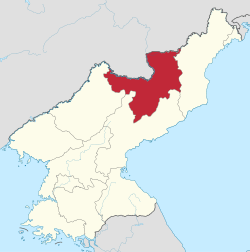Ryanggang Province
Ryanggang Province (Ryanggangdo; Korean: 량강도, Ryanggang-do, Korean pronunciation: [ɾjaŋ.ɡaŋ.do]) is a province in North Korea. The province is bordered by China (Jilin) on the north, North Hamgyong on the east, South Hamgyong on the south, and Chagang on the west. Ryanggang was formed in 1954, when it was separated from South Hamgyŏng. The provincial capital is Hyesan. In South Korean usage, "Ryanggang" is spelled and pronounced as "Yanggang" (Korean: 양강도, Yanggang-do, Korean pronunciation: [jaŋ.ɡaŋ.do])
Ryanggang Province 량강도 | |
|---|---|
| Korean transcription(s) | |
| • Chosŏn'gŭl | 량강도 |
| • Hancha | 兩江道 |
| • McCune‑Reischauer | Ryanggang-do |
| • Revised Romanization | Yanggang-do |
 | |
| Country | North Korea |
| Region | Kwannam |
| Capital | Hyesan |
| Subdivisions | 2 cities; 10 counties |
| Government | |
| • Party Committee Chairman | Ri Sang-won[1] (WPK) |
| • People's Committee Chairman | Ri Song-guk[1] |
| Area | |
| • Total | 14,317 km2 (5,528 sq mi) |
| Population (2008) | |
| • Total | 719,269 |
| • Density | 50/km2 (130/sq mi) |
| Time zone | UTC+9 (Pyongyang Time) |
| Dialect | Hamgyŏng |
Description
Along the northern border with China runs the Yalu River and the Tumen River. In between the rivers, and the source of both, is Paektu Mountain, revered by both the Koreans and Manchurians as the mythic origin of each people. The North Korean government claims that Kim Jong-il was born there when his parents were at a Communist resistance camp at the mountain. The North Korean-Chinese border for 20 miles east of the mountain is "dry, remote and mountainous, barely patrolled," making it one of the crossing areas for refugees from North Korea into China, although most, including refugees from Ryanggang itself, prefer to cross over the Tumen River.[2]
Although all of North Korea is economically depressed, Ryanggang province, along with neighboring North Hamgyong and South Hamgyong provinces, are the poorest, forming North Korea's "Rust Belt" of industrialized cities with factories now decrepit and failing. The worst hunger of the 1990s famine years occurred in these three provinces, and most refugees into China come from the Rust Belt region.[2]
Ryanggang explosion
An explosion and mushroom cloud was reportedly detected in Kimhyŏngjik-gun on 9 September 2004, the 56th anniversary of the creation of North Korea. This was reported a few days later on 12 September.
Power supply issues
In recent years, power supply problems have become prevalent in Ryanggang.
Administrative divisions
Ryanggang is divided into 2 cities ("Si") and 10 counties ("gun").
- Hyesan-si (혜산시; 惠山市)
- Samjiyŏn-si (삼지연시; 三池淵市)
- Kapsan-gun (갑산군; 甲山郡)
- Kimjŏngsuk-gun (김정숙군; 金貞淑郡) formerly Sinpa-gun (신파군; 新坡郡)
- Kimhyŏnggwŏn-gun (김형권군; 金亨權郡) Pungsan-gun formerly (풍산군; 豊山郡)
- Kimhyŏngjik-gun (김형직군; 金亨稷郡) formerly Huch'ang-gun (후창군; 厚昌郡)
- Paegam-gun (백암군; 白岩郡)
- Poch'ŏn-gun (보천군; 普天郡)
- P'ungsŏ-gun (풍서군; 豊西郡)
- Samsu-gun (삼수군; 三水郡)
- Taehongdan-gun (대홍단군; 大紅湍郡)
- Unhŭng-gun (운흥군; 雲興郡)
See also
- List of Korea-related topics
References
- "Organizational Chart of North Korean Leadership" (PDF). Seoul: Political and Military Analysis Division, Intelligence and Analysis Bureau; Ministry of Unification. January 2018. Retrieved 17 October 2018.
- Onishi, Norimitsu (22 October 2006). "Tension, Desperation: The China-North Korean Border". New York Times. The information cited in this footnote comes from the captions to the large illustrated map published with the newspaper article and available online with it.
External links
| Wikimedia Commons has media related to Ryanggang-do. |
- 행정 구역 현황 (Haengjeong Guyeok Hyeonhwang) (in Korean only)